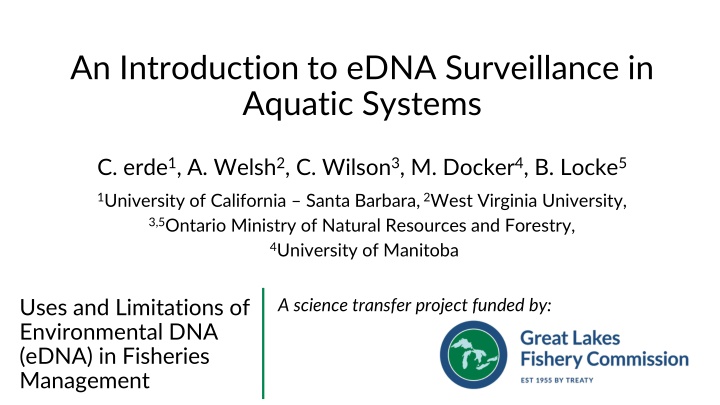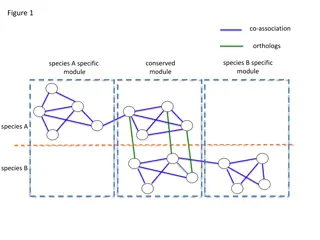
Introduction to eDNA Surveillance in Aquatic Systems
Learn about environmental DNA (eDNA) surveillance in aquatic systems, how it works, why it is used, and the advantages it offers in fisheries management. Discover the process of eDNA surveillance, its applications for hard-to-catch species, and factors that can impact the detection of eDNA in the presence of fish. Explore the benefits of eDNA analysis through active and passive surveillance techniques.
Download Presentation

Please find below an Image/Link to download the presentation.
The content on the website is provided AS IS for your information and personal use only. It may not be sold, licensed, or shared on other websites without obtaining consent from the author. If you encounter any issues during the download, it is possible that the publisher has removed the file from their server.
You are allowed to download the files provided on this website for personal or commercial use, subject to the condition that they are used lawfully. All files are the property of their respective owners.
The content on the website is provided AS IS for your information and personal use only. It may not be sold, licensed, or shared on other websites without obtaining consent from the author.
E N D
Presentation Transcript
An Introduction to eDNA Surveillance in Aquatic Systems C. erde1, A. Welsh2, C. Wilson3, M. Docker4, B. Locke5 1University of California Santa Barbara, 2West Virginia University, 3,5Ontario Ministry of Natural Resources and Forestry, 4University of Manitoba Uses and Limitations of Environmental DNA (eDNA) in Fisheries Management A science transfer project funded by:
What is environmental DNA (eDNA)? All organisms shed cells into the environment (e.g. dandruff). In aquatic systems, DNA from species is released into the water in the form of sloughed cells found in urine, feces, and mucus. The DNA can be found in small organelles (parts of cells like the mitochondria) or in larger pieces of tissue made up of many cells. The idea is that it is easier to catch the DNA than it is to catch the fish!
Why do we use eDNA? Not all species are easy to catch using traditional methods (hook and line, nets, electrofishing, trawls) Even when species are easily caught, if the species is rare, then they are often missed In large systems, such as the Laurentian Great Lakes, it is impossible to sample everywhere using traditional methods eDNA can be applied for difficult to capture species, at low abundance, in places where traditional methods are difficult to deploy, and across vast landscapes
How does eDNA surveillance work (in general)? A water sample is collected The DNA is isolated on a filter The DNA is extracted from the filter The DNA is screened for presence of the organism s telltale signature There are two general ways the DNA can be screened
Once the sample is collected, filtered, and the DNA is extracted, the DNA can be screened using two different approaches Active surveillance: using technology and molecular techniques to evaluate if a species is present (e.g. PCR, qPCR, ddPCR) Passive surveillance: using technology and molecular techniques to evaluate the presence and identity of many species (High-Throughput Sequencing (HTS))
What can prevent eDNA from being detected when a fish is present? DNA degrades at different rates: Temperature pH Inhibitors (e.g. humic acid) Microbes and enzymes
How can eDNA be detected WITHOUT a live fish being present? 1. Contamination DNA of the species unintentionally getting into supplies, chemicals, instruments used in the eDNA method 2. Misidentification Morphometric identification of fish is different from genetic identification 3. Hybridization eDNA uses mitochondrial DNA which is materially inherited; if parents are two species, progeny may look like one species but have the genetic signature of the other 4. Dead fish DNA persists in the environment beyond the life span of the organism 5. Fish swim The fish s DNA is in the environment but the fish has left the area 6. Vectors of DNA transport some other mechanism, other than a live fish, has allowed DNA to be transported into the system. Ex: water flow, fish eating birds defecating in the water Best practices, updated species lists, basic biology research, and testing of alternative explanations can address these issues






















